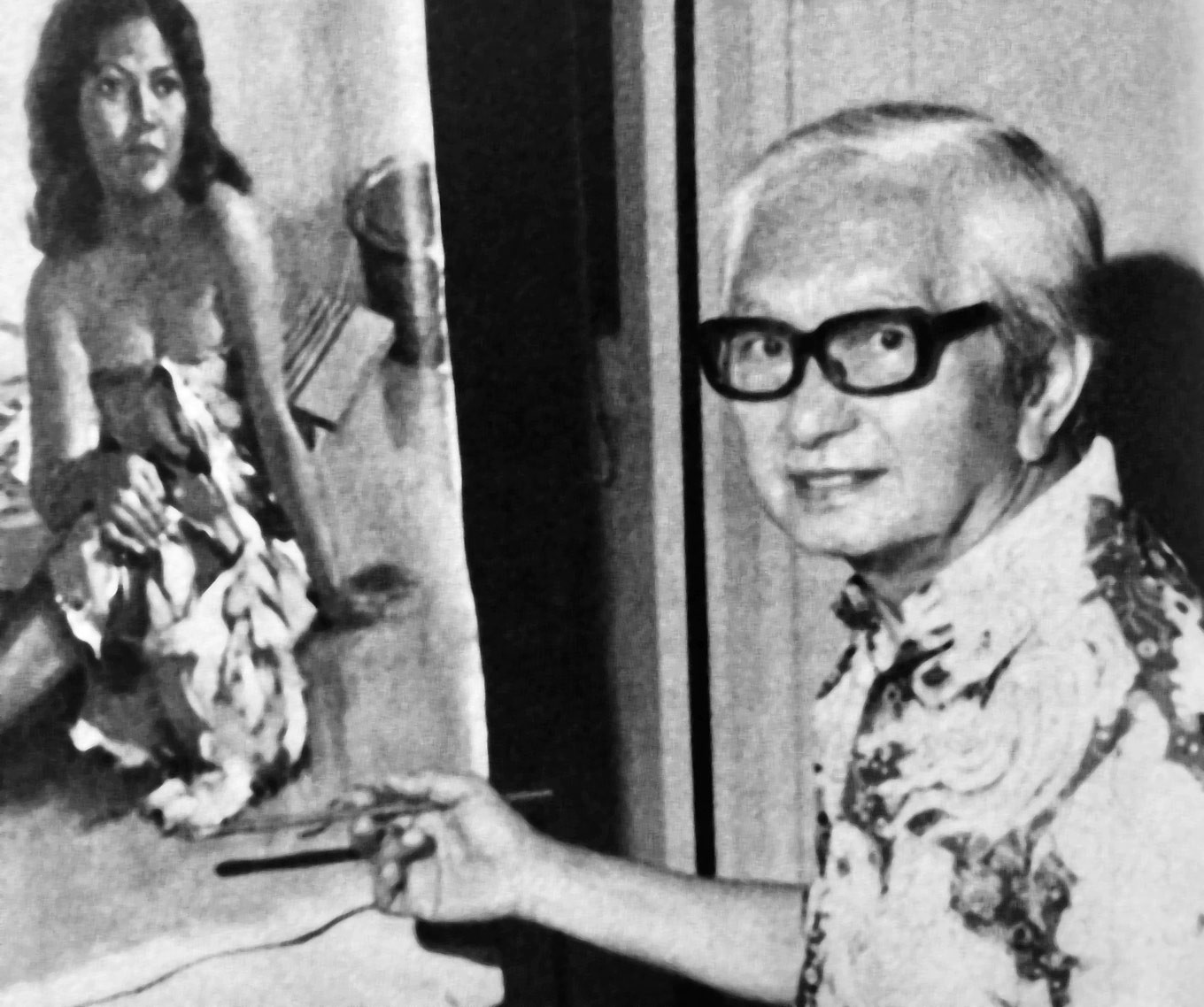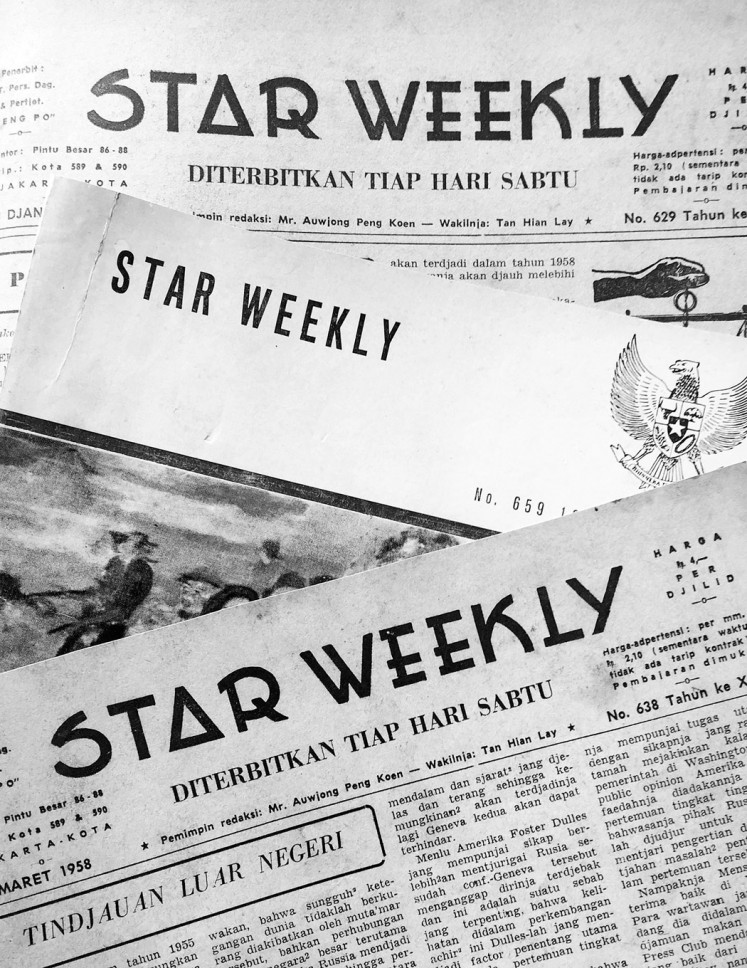Popular Reads
Top Results
Can't find what you're looking for?
View all search resultsPopular Reads
Top Results
Can't find what you're looking for?
View all search resultsRemembering the author of 'Sie Jin Kui'
Comics lovers certainly remember Siauw Tik Kwie, a household name for Sie Djin Koei, the illustrated story appearing on Star Weekly, Indonesia’s family magazine of the 1950 and 1960s.
Change text size
Gift Premium Articles
to Anyone
E
xactly 30 years ago, Siauw Tik Kwie, the creator of legendary comic strip Sie Djien Koei, passed away. His wife, Tan Poen Nio, better known as Kartini, passed away this year on April 16, the same day of the year as her husband’s death.
Comics lovers certainly remember Siauw Tik Kwie, a household name for Sie Djin Koei, the illustrated story appearing on Star Weekly, Indonesia’s family magazine of the 1950 and 1960s.
Sie Jin Kui, as currently spelled, is the folkloric story during the Tang dynasty (618-906) of a general in the empire of Tang Toay Cung under Emperor Li Shi Bin (627-649). Starting as a manual worker, Sie Jin Kui displayed high spirits and was so powerful that he carried loads of five times more weight than his peers.
His physical prowess was noticed by a wealthy royal, who then employed Sie Jin Kui in his mansion. Later, Sie Jin Kui and the nobleman’s daughter fell in love and eloped. He joined the military and his career progressed, finally reaching the rank of general.
The Sie Jin Kui comic strip was created with the help of a martial arts writer known as OKT (Oei Kim Tia), who translated the account from its original manuscript. Siauw made the comic illustrations with his mastery of anatomical outlines and stunning chiaroscuro (light and shade treatment in drawing).
The comics are published in two parts, Sie Jin Kui Invades the East and Sie Jin Kui Invades the West, as a popular section of the Saturday periodical Star Weekly. Allotted one page per edition, Sie Jin Kui received a positive public response and prompted new readers to subscribe to the magazine.
This success led to expectations that Siauw would write other comics, but he once said he just wanted to create this one and only story. Later on, however, it was revealed that he was interested in making a Sie Jin Kui sequel, and had even come up with a title, Hong Kiauw-Lie Tan, which would depict the crisis faced by Sie Jin Kui’s grandchildren.
Sadly, his wish did not come true as Star Weekly was banned in 1966 in the aftermath of the 1965 incident. According to Marcel Bonneff, a comics observer from France, Sie Jin Kui managed to overwhelm Western comics entering the Indonesian market.
The popularity of Sie Jin Kui spread further, prompting the adoption of the story for a local radio program in 1960 by Tjokrodjijo, the leader of Ketoprak Mataram (a history-based Javanese play) of the state-run Radio Republik Indonesia. It was broadcast on Wednesdays from 8:30 p.m. until midnight and became popular with listeners.
Tjokrodjijo was a fan of Siauw’s comics. In his radio version, Sie Jin Kui was renamed Sudiro, Sie Teng San (Jin Kui’s son) Sutrisno and Hoan Le Hoa (Teng San’s opponent) Waryanti.
Siauw’s works continue to shine in the 21st century. N. Riantiarno, a playwright and director of Teater Koma in Jakarta, staged Sie Jin Kui in the first decade of the millennium.
“The comics’ storyline is worth understanding while exploring its costumes, characters and movements,” he said.
Siauw’s comic strip debut was encouraged by Star Weekly editors Tan Hian Lay and Auwyong Peng Koen (PK Ojong), who later founded Kompas daily with Jakob Oetama.
“It was Pak Ojong who made me popular,” Siauw was quoted as saying.
Sie Jin Kui’s pictorial rendition totaled 700 pages and was published from 1954 to 1961.
The comics thus recorded the longest time for creation because of PK Ojong’s working system, allowing Siauw to draw the strips by weekly installments. Drawn on broadsheet pages with India ink and a brush pencil, the comics kept flowing without a hitch.
In real world: A view of Kweilin, now known as Guilin, a city located in Guangxi, China. (JP/Agus Dermawan T.)Uniquely, the settings in his comics were only based on his imagination as he had never visited mainland China to witness the interior and exterior of the Chinese kingdoms. Costumes and property were drawn out of his observations of wayang potehi (Chinese hand puppets) shown in Surakarta in Central Java and Jakarta temples. Forms of weapons were derived from martial arts clubs and Beijing opera photos.
He eventually visited Kweilin, the beautiful location of Sie Jin Kui, only at the end of 1987, sponsored by Tjokroatmodjo, a collector of his paintings. Returning from Kweilin, his health deteriorated and he died on April 16, 1988. Before his death Siauw said his life was already complete and Kweilin was seen as his heaven.
Siauw Tik Kwie disappeared for a while following the 1965 incident. A Chinese-Indonesian, he once hid under the Javanese pen name Ki Oto Suastika while translating the philosophical text of Ki Ageng Suryomentaram from Javanese to Indonesian.














